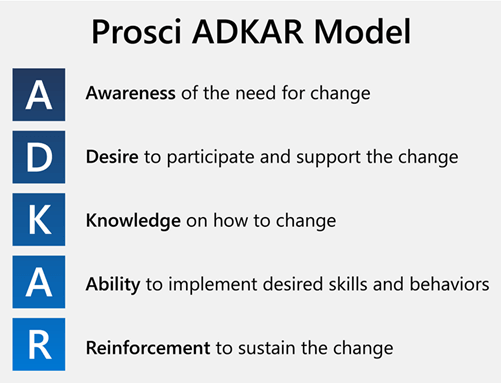This content has been archived, and while it was correct at time of publication, it may no longer be accurate or reflect the current situation at Microsoft.
 It was time for a fresh approach to data analysis at Microsoft, one that would make it easier to track sales and operations activities across regions and roles. In addition to tool development, a dedicated change management effort was needed to inspire global adoption of a new, common methodology.
It was time for a fresh approach to data analysis at Microsoft, one that would make it easier to track sales and operations activities across regions and roles. In addition to tool development, a dedicated change management effort was needed to inspire global adoption of a new, common methodology.
In 2020, the Microsoft Business Operations and Programs team in Microsoft Digital partnered with teams across the company, including Commercial Sales and Marketing, Worldwide Sales Engineering, Partner Seller Exchange, Microsoft Cloud Data Sciences, Microsoft Sales, Microsoft Finance, and others to deliver and drive adoption of a modern business intelligence reporting solution called MSX Insights (MSXi).
Today, MSXi serves as a single version of the truth for salespeople, managers, company leaders, operations, and finance teams across Microsoft. The change management process needed to reach this milestone started with a thorough assessment of the current state.
In the old system, despite an abundance of data, it was often a challenge for Microsoft’s leaders, the sales organization, and the Microsoft Finance team to align on key metrics. Each team’s reports used different data sources, making it hard to discuss risks and issues or have effective coaching conversations.
This duplication of effort and lack of automation made data analysis at Microsoft more costly than it had to be. As users routinely made multiple copies of data sets, compliance with data privacy and handling regulations and standards was also at risk.
“Wouldn’t it be great if we could have a common and standard way of looking at data, of drilling down into the business insights?” says Andrew Osten, senior director in Microsoft Digital for Microsoft Digital’s Employee Experience organization.
The MSXi project v-team agreed and began creating a solution that would meet the requirements of a range of users across the Microsoft ecosystem.
“What a leader might need is different from what a sales manager might need for their insights, or a front-line seller,” Osten says. “We asked, ‘what do they need to see and what behavior are we trying to drive?’”
The engineering challenges were significant. To solve them, the team chose a technical architecture based on Microsoft Azure technologies, including Azure Data Lake, Azure Data Factory, Azure Synapse Analytics, Azure Analysis Services, and Microsoft Power BI. MSXi was built on top of the Enterprise Data Lake, a shared data lake foundation central to the broader data strategy in Microsoft Digital. In addition to providing the needed data in a single secured, governed, and scalable location, this enabled the MSXi team to focus exclusively on building the needed analytics solution to help transform sales operations.
Convincing the users to switch to a single solution like MSXi wasn’t going to be easy.
“The primary obstacles were not technical,” says Rudy Neirynck, senior business program manager in Employee Experience. “Even at Microsoft, people do not just accept new business processes and go work the way you tell them to. Decision-making around the BI strategy and tactics is quite distributed at Microsoft, and many employees are great at creating reports with our company’s products.”
[Learn how Microsoft is powering its digital transformation with Modern Data Foundations. Learn how Microsoft improved data handling with a revamped business intelligence platform. See how moving Microsoft’s financial reporting processes to Microsoft Azure unlocked data value. Find out how Microsoft transformed sales with AI-infused recommendations and customer insights.]
Change management and telemetry
As the design of the MSXi solution took shape, the project v-team also had to address change management. This workstream refers to the cycle of communications, training, and reinforcement of a new framework, process, or structure.
“We implemented change management best practices from Prosci, including the valuable ADKAR model. ADKAR describes five important aspects of change: Awareness, Desire, Knowledge, Ability, and Reinforcement,” Neirynck says.

This model provides insight into where to focus resources to encourage the desired shift in behavior.
During development, Microsoft Digital business program managers ran pilot projects in all geographies, including the Latin America region and Australia.
“We tied telemetry into Microsoft listening systems to understand exactly what was happening,” says Juan Sarmiento, senior business manager in Microsoft Digital’s Employee Experience organization. “This helped to provide a data-driven view into adoption by people in the various sales roles, from leaders to managers and sellers.”
We had to drive the desire to find out what this solution has and what value it can bring.
—Andrew Osten, senior director, Microsoft Digital, Employee Experience
There were structured feedback channels in place for every audience.
“We wanted to keep the contact with the end-user as close as possible,” Neirynck says. “We asked the areas to triage issues first, then we had weekly or bi-weekly sessions to prioritize corporate and field needs.”
With this level of attention to detail and documented knowledge of the most common potential change blockers, the team was able to zero in to resolve the primary issues.
“We worked daily to identify the key blockers,” Osten says, “including lack of technical training and missing executive sponsorship. We had to drive the desire to find out what this solution has and what value it can bring.”
The team found the people driving reporting in each area and asked them to help champion the change. A key strategy was to ask about their challenges with metrics and listen carefully to the answers.
“Here’s a solution we’re developing, does it meet your needs?” Osten says. “What are your top three priorities that you can’t live without? They may already be covered. If not, let’s build a business case to get them in there.”
MSXi adoption is growing across the company
Today there are more than 30,000 users of this business intelligence platform, in 95 countries, across 14 regions. The monthly average usage rate for leaders is more than 80 hours, reflecting the team’s focus on gaining sponsorship among executives.
“It was near-zero when we started,” Neirynck says. “The manager number is up to about 50-60 hours a month. It starts with winning the hearts and minds of corporate and field leaders.”
Reporting on its own has limited value if it is not supported by a process. “If the leader is not integrating these instruments and insights into their day-to-day management of the business, it doesn’t fly,” Sarmiento says. A popular way to use the system reports is to support quarterly business reviews with standard key performance indicators (KPIs).
“We are transforming the company with data,” says Michael Toomey, senior director in the Microsoft Customer and Partner Solutions organization. “We are showcasing our solutions and inspiring the sales force at the same time. It is an amazing use of Microsoft Dynamics CRM, Azure Synapse, and Power BI.”
The demand for increasingly near real-time data from executives and managers has increased since the project started. “We never dreamed they would want the data refreshed so often,” Neirynck says. “At first it was daily, then every 12 hours, and now in some cases, it’s 10 times per day.”
What was most important for effective change management?
The close partnership between Microsoft Digital, the landing and adoption team, and engineering helped make this project successful. “Our people are well-trained, technically capable, and know the message of what’s in it for the field, for each role,” Neirynck says.
Another piece of the puzzle was to map the groups of stakeholders and provide each with a tailored, consistent message while being prepared for questions. The team tried to anticipate likely obstacles, documented its learnings, and deployed action plans in areas like delivery, adoption, and business readiness.
“We encouraged user dialogue around the KPIs, how they could gain business insights more consistently, and what metrics they need to see in each scenario,” Osten says.
It wasn’t just about raising awareness of the new platform. At first, the desire for the solution was low, partly because local teams could not verify the accuracy of the data. Some areas had created their own dashboards and didn’t want to make process changes.
“How and when do you start trusting this data in MSXi vs. what teams created offline?” Sarmiento says. “We took the time to define the data quality standards and process steps to overcome the perception that the data was unreliable.”
It’s a constantly changing environment. Have we continued to deliver the right thing at the right time for the right people?
—Juan Sarmiento, senior business program manager, Microsoft Digital, Employee Experience
At first, the team put more focus on executives and specialists. More roles were added over time.
“We identified issues with certain audiences who were not getting what they needed,” Neirynck says. “It was important to do a lot of monitoring of what people look at to make the right choices for our users.”
Improving platform functionality, accessibility, and process integration
Six months ago, the team went through the ADKAR process again to refresh on the needs of stakeholders and address advances in Microsoft’s business model.
“It’s a constantly changing environment,” Sarmiento says. “It never stays still, we are never there, it is a continuous process. Have we continued to deliver the right thing at the right time for the right people?”
Business analytics are part of an end-to-end process. Today’s tools are more and more interconnected, but people become overwhelmed when they have to use several systems to answer their questions.
“We created the Business Performance Management (BPM) framework to help align Microsoft teams with centrally defined BPM metrics and to simplify our current reports and insights,” Sarmiento says. “The BPM dashboard serves as the core, one source of truth for business performance across our leadership teams and all up for the Microsoft Customer and Partner Solutions organization.”
The change management strategy focused in incorporating a BPM Dashboard into the company processes to reduce the preparation time for rhythm of business meetings, bring together performance results against key outcomes and execution activities, provide prescriptive scenarios to drive actions and impact the bottom line, while leveraging machine learning algorithms to expose risks and propensity flags.
“The demand is growing to have the insights integrated with the user’s day-to-day environment,” Neirynck says. “How do you make sure the whole thing works in a fluid, connected way? This is the next dimension that we’re dealing with.”

- Understand the needs of your user groups (e.g., leaders, managers, sellers), and think clearly on which behaviors you need to drive to incorporate it your change management strategy.
- Consider how to integrate your analysis and reports into your business processes as a critical success factor for your business intelligence/BPM change management strategy.
- Establish a robust listening mechanism and monitor the adoption of your analysis and reports continuously at the role level, to identify the groups that need more assistance, and where awareness, desire, knowledge, ability, or reinforcement actions are required.
- Carefully check to make sure your solution meets your business needs and be sure to identify and remove your key blockers.
- Be patient as Business Intelligence/BPM standardization are not easy and require continuous work and well-established connections between corporate and local teams.









